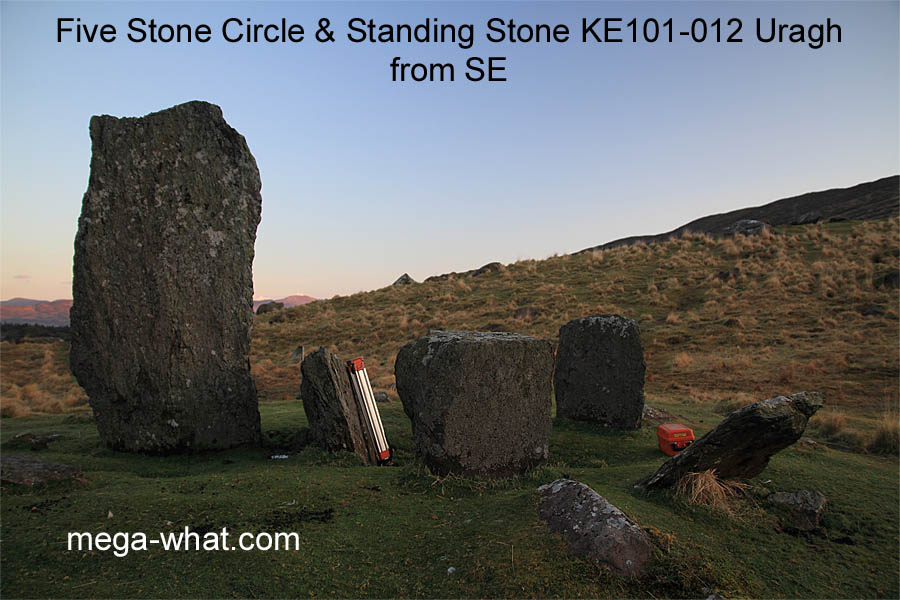 Uragh Five Stone Circle & Standing Stone are in Gleninchaquin, about 10km south-west of Kenmare, 8km north-east of Lauragh as the crow flies.
Signposted and open to the public (small fee) with parking provided. A popular spot, beside Lough Inchiquin and on the Beara Way footpath.
Uragh Five Stone Circle & Standing Stone are in Gleninchaquin, about 10km south-west of Kenmare, 8km north-east of Lauragh as the crow flies.
Signposted and open to the public (small fee) with parking provided. A popular spot, beside Lough Inchiquin and on the Beara Way footpath.
The centre of this small circle has been dug out, almost certainly by treasure seekers. The standing stone was probably set there by an earlier group of people.
 South is on the highest hilltop. The height of it means that south lunisticesLunistices are the most northerly and southerly moons of the month. The lunar equivalent of solstices - more.
are not visible for about 8 years during the major half of the cycle [Pic].
South is on the highest hilltop. The height of it means that south lunisticesLunistices are the most northerly and southerly moons of the month. The lunar equivalent of solstices - more.
are not visible for about 8 years during the major half of the cycle [Pic].
North is left of a hilltop but over the top of the local rise and between two prominent boulders [Pic].
 The north-east is the nearest and most easily managed horizon. Major standstillsLunistice positions vary cyclically over an 18.6 year period but are fairly static for more than a year at either end of the range
and summer solstices are straining to reach tops. Solstice / cross-quarter midpoints are in a dip.
The north-east is the nearest and most easily managed horizon. Major standstillsLunistice positions vary cyclically over an 18.6 year period but are fairly static for more than a year at either end of the range
and summer solstices are straining to reach tops. Solstice / cross-quarter midpoints are in a dip.
Axes are confused because of monument juxtaposition. The standing stone may indicate summer solstice but the circle axis is somewhat further south [Pic].
 Equinox sunrises are at a break in a slope, between quarter-month brackets on tops. Winter cross-quarters are in a dip, summer ones at a break in a slope.
This segment starts and ends a week south of the cross-quarters (before Imbolc & Bealtainne but after Lughnasadh & Samhain).
Equinox sunrises are at a break in a slope, between quarter-month brackets on tops. Winter cross-quarters are in a dip, summer ones at a break in a slope.
This segment starts and ends a week south of the cross-quarters (before Imbolc & Bealtainne but after Lughnasadh & Samhain).
 Winter cross-quarters are in a dip of the far horizon. The local slope is critically precise for the minor end of the lunisticeLunistices are the most northerly and southerly moons of the month. The lunar equivalent of solstices - more.
cycle and lunar precedence follows on until the dip indicates the end of the period centred on lunar mid-cycle.
Winter cross-quarters are in a dip of the far horizon. The local slope is critically precise for the minor end of the lunisticeLunistices are the most northerly and southerly moons of the month. The lunar equivalent of solstices - more.
cycle and lunar precedence follows on until the dip indicates the end of the period centred on lunar mid-cycle.
 The hilltop and south-western slope are critical for lunar mid-cycle and the following notch / step is an exact sixteenth.
A handy step indicates the minor end of the cycle and winter cross-quarters are on a hilltop.
The hilltop and south-western slope are critical for lunar mid-cycle and the following notch / step is an exact sixteenth.
A handy step indicates the minor end of the cycle and winter cross-quarters are on a hilltop.
 Westwards, the equinox is in the middle of a slope that is half-way to the cross-quarters at top and bottom. Winter and summer cross-quarters are marked by hilltops.
Westwards, the equinox is in the middle of a slope that is half-way to the cross-quarters at top and bottom. Winter and summer cross-quarters are marked by hilltops.
The axis of the circle is perhaps a half-month before spring equinox [Pic] but the standing stone was probably there first and its axis is perhaps a couple of weeks further south [Pic].
At the intersect of near and far, the equinox / cross-quarter midpoint is at the left side of a hill.
 At the intersect of far and near, major standstillLunistice positions vary cyclically over an 18.6 year period but are fairly static for more than a year at either end of the range
is at the left side of a hill. Summer cross-quarters are marked by a hilltop and solstices by a dip.
At the intersect of far and near, major standstillLunistice positions vary cyclically over an 18.6 year period but are fairly static for more than a year at either end of the range
is at the left side of a hill. Summer cross-quarters are marked by a hilltop and solstices by a dip.
- Uragh Multiple Stone Circle & Boulder-Burials are c.800m south-west (235°) up the hill
- Another Five Stone Circle (damaged) is c.500m north-east (57°) beside the river
- Cooryeen Boulder-Burials & Standing Stone are c.700m north-east (72°) on the other side of the valley
- Drombohilly Stone Circle is c.5km south-west (236°)
References
- Archaeological Survey of Ireland, record details. www.archaeology.ie/archaeological-survey-ireland
- BYRNE, ELIZABETH et al. 2009 Archaeological Inventory of County Kerry, Volume I: South-West Kerry. Dublin: Stationary Office. p20, no.75; p55, no.355.
- TWOHIG, ELIZABETH 1987 Two stone circles at Uragh, Co. Kerry. Journal of the Kerry Archaeological & Historical Society 20:111-118.
